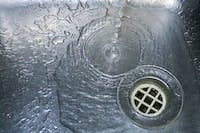The U.S. Environmental Protection Agency (EPA) has finalized the first WaterSense specification for a commercial kitchen product. EPA estimates that approximately 51 billion gal of water is used every year to rinse dishes by close to 1 million food service establishments in the country. Pre-rinse spray valves—which remove excess food waste from dishes prior to dishwashing—are now eligible to earn the WaterSense label and help food service establishments save water, energy, and money.
If every U.S. commercial food service establishment installed and used a WaterSense labeled pre-rinse spray valve, more than 10 billion gallons of water and more than $225 million in water and energy costs could be saved. It would also prevent the equivalent of 900,000 tons of carbon dioxide emissions—equal to the emissions from 187,500 passenger vehicles—annually across the country.
Like all WaterSense labeled products, pre-rinse spray valves that earn the label must be independently certified for efficiency and performance. Working in conjunction with industry stakeholders, EPA specifies a maximum flow rate for WaterSense labeled pre-rinse spray valves of 1.28 gal per minute, 20% less water than the federal standard. To ensure that these fixtures will work well and meet the demands of high-volume kitchens while using less water, EPA also includes spray force performance criteria and a requirement for life cycle testing for the products to earn the WaterSense label.
“Pre-rinse spray valves can account for nearly one-third of the water used in a typical commercial kitchen,” said EPA Acting Administrator for Water Nancy Stoner. “Replacing just one of these fixtures with a WaterSense labeled model can save a typical restaurant more than 7,000 gal of water per year, the amount of water needed to wash nearly 5,000 racks of dishes.”
Restaurants and commercial kitchens are one of the highest energy consumers in commercial buildings, using approximately five to eight times more energy per square foot than other commercial spaces. Outfitting a kitchen with WaterSense labeled pre-rinse spray valves, along with Energy Star certified food service products, will save energy and water.
A restaurant that replaces just one pre-rinse spray valve with a WaterSense labeled model could recoup its investment in four to eight months and save more than $115 per year on water and energy costs, depending on how its water is heated. WaterSense labeled pre-rinse spray valves will be promoted by EPA’s ENERGY STAR program as part of a suite of energy saving products and practices for the restaurant industry.
To develop the specification, WaterSense worked with a project team associated with the American Society of Mechanical Eng. (ASME)/Canadian Standards Assn. (CSA) to evaluate pre-rinse spray valve performance and develop a meaningful test protocol. The ASME/CSA project team was open to the public and comprised a wide variety of stakeholders, including manufacturers, utilities, testing laboratories, representatives from ASTM International, and other water efficiency experts.
Source: EPA


